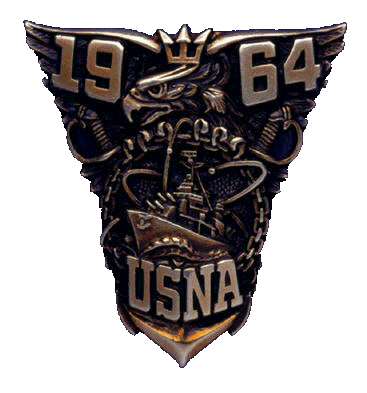On July 5, 1960, 1,265 young men took the oath to become Midshipmen in the United States Navy at the Naval Academy at Annapolis Maryland. Four years later, 917 classmates graduated and were commissioned ensigns in the Navy or second lieutenants in the Marine Corps.
I just returned from Annapolis where we celebrated the 50th Anniversary of that graduation. Four-hundred-forty-five graduates attended, nearly 60 percent of the 770 living graduates. We reminisced on the remarkable journey we had made over five decades, and honored our 174 deceased classmates.
The years in Annapolis were physically and academically rigorous. Plebe, or freshman, year is designed to test the new midshipmen’s ability to deal with stress, physical fitness, and a heavy academic load. About 14 percent of the class did not complete plebe year.
A transcendent bonding experience for the class was the success of our athletic teams. We were national lacrosse champions all four years, and national lightweight football champions two years. Senior year we reached the finals of the national soccer championship.
BUT THE HIGHLIGHT WAS FOOTBALL. We beat our historic rival Army all four years, and beat the Air Force Academy in our only encounter. Senior Joe Bellino won the Heisman Trophy our plebe year, and junior Roger Staubach won the Heisman our senior year. That year Navy played Texas for the national championship.
We lost the championship game, but these were great years for Navy football. The Navy program remains highly successful, but competing for a national championship is a stretch. There are too few of the very best high school players who can qualify for the Academy and consider service to country more important than the potential riches of the NFL.
We marched in President John F. Kennedy’s inaugural parade, and in his funeral procession. Upon graduation approximately a third of us went to surface ships, a third into aviation, about a fifth to submarines, a 10th into the Marine Corps, and 5 percent to Navy staff corps.
Vietnam loomed over us, and we were soon embroiled in that war, with destroyer men commanding riverine patrol boats, aviators dropping bombs throughout Vietnam, and Marines fighting fierce land battles.
We lost nine classmates in Vietnam, including the All-American captain of our swim team who was a SEAL. Five aviators were POWs in Hanoi, and we lost a classmate when the submarine U.S.S. Scorpion went down. Including Vietnam and operational accidents, we lost 25 classmates in the line of duty.
During and after Vietnam we participated in Cold War operations until the collapse of the Soviet Union in 1991. As children of the ‘50s, this was the war we had expected to engage throughout our careers, and there was great satisfaction that we had contributed to its successful conclusion.
Classmates commanded destroyers, cruisers, aircraft carriers, submarines, aircraft squadrons, Marine battalions, and important shore stations. One classmate was a Blue Angel, one an astronaut, and two were commandants of midshipmen at the Academy.
THE CLASS PRODUCED 20 ADMIRALS and two generals. They commanded Carrier Battle Groups; Cruiser Destroyer and Submarine Groups; the Surface, Air, Submarine, and Marine Forces in the Pacific; and the Third and Sixth Fleets. One was Superintendent of the Naval Academy, another Commandant of the Marine Corps, and still another Commander of the Pacific Command.
In civilian life, classmates distinguished themselves in government service as the U.S. Ambassador to China, the secretary of the Navy, administrator of National Oceanic and Atmospheric Administration, and superintendent of the U.S. Merchant Marine Academy.
Others served as NATO assistant secretary general; deputy director of the Federal Emergency Management Agency, deputy undersecretary of defense; and two as deputy assistant secretaries of defense.
One served as chairman of the board of Georgia Tech Research Corporation, and another is currently a college president. Four classmates were mayors of their cities or towns, and nearly all of us assumed leadership roles in our local church, civic, charitable, professional and service organizations.
Numerous classmates left the Navy and Marine Corps to pursue graduate education. Many had distinguished careers in business, law, finance, medicine, education and the clergy. Several became corporate CEOs, and another survived horrific injuries in Vietnam and became an acclaimed journalist and author.
As we neared the end of our active duty careers, we gave back to the Academy by funding projects to enhance military ethics. We published a book for the midshipmen titled Ethics for the Junior Officer, a compilation of case studies of real-life ethical issues facing young officers.
We then provided initial funding for what has become the Vice Adm. James B. Stockdale Center for Ethical Leadership. The Stockdale Center conducts world class research and programs to fulfill its mission to “enhance the ethical development of current and future military leaders.” Most recently, we are sponsoring a series of inspirational videos for the midshipmen that demonstrate the need for ethical behavior.
Who made up the class when we arrived in Annapolis? Seventy-percent of us were varsity athletes, and 30 percent had previous college or post high school education. Two-thirds of us stood in the upper quarter of our high school class, and our mean SAT score was 1221. More than half were student body or class officers.
WE WENT THROUGH CHALLENGING TIMES together as midshipmen, in Vietnam, and during long deployments at sea.
Little did we know, when we reported aboard the Naval Academy more than half a century ago, that these common experiences would bind us together, creating a brotherhood of 900 men. That brotherhood, now reduced in numbers, remains the treasure of our class.
The Naval Academy Mission is to develop Midshipmen “...who are dedicated to a career of naval service and have potential for future development...to assume the highest responsibilities of command, citizenship and government.”
Throughout the yard, as the Academy campus is called, are banners proclaiming “Leaders to Serve the Nation.” That is not only an excellent expression of the Academy’s mission, it accurately describes the journey of the Naval Academy Class of 1964.
